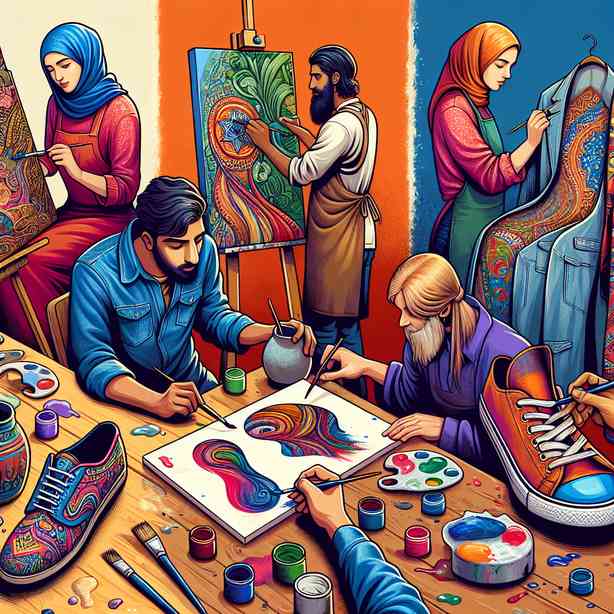
When you think about painting, the traditional canvas often comes to mind: a sturdy frame, a smooth surface, and limitless possibilities for creativity. However, the world of painting extends far beyond the boundaries of canvas. Artists around the globe are exploring various unconventional surfaces, transforming everyday materials into vibrant pieces of art. This exploration not only expands the creative potential but also challenges the very definition of what art can be. In this discussion, we will delve deep into the myriad surfaces on which artists can paint, the techniques involved, and the conceptual implications of such choices.
First and foremost, let’s consider paper. It is one of the most accessible and versatile materials for painting. While many associate paper primarily with drawing, it can also serve as a fantastic medium for painting, particularly with watercolors and acrylics. Various types of paper, such as watercolor paper, cottage paper, and mixed-media paper, allow artists to experiment with texture and absorbency. Watercolor paper, for instance, comes in different weights and textures, which can significantly influence the final artwork. Techniques such as wet-on-wet, dry brush, or even pouring paint can result in a range of effects that might be unexpected on canvas. Furthermore, paper can be easily manipulated—folded, torn, or layered—adding an interesting dimension to the artwork that a flat canvas simply cannot provide.
Next, let’s address wood. Painting on wood surfaces offers a unique aesthetic and texture that can greatly enhance the artwork’s appeal. The grain and variation in wood can create a natural backdrop that complements the painting itself. Artists like Gustav Klimt have famously used wood in their work, often applying gold leaf and intricate designs that play beautifully against the natural wood background. When painting on wood, it’s essential to prepare the surface properly. Sanding the wood smooth and applying a primer can help prevent the paint from soaking into the wood too quickly, ensuring that vibrant colors remain true and the details sharp. This preparation is crucial if using oil paints, which can have a different interaction with the wood than acrylics.
Moving beyond traditional painting surfaces, artists have also turned to fabric. Painting on textiles, such as denim, silk, or cotton, allows for a novel form of self-expression. Textile art can transform ordinary clothing or home decor into expressive canvases, which not only showcase artistic talent but also create functional art pieces. Techniques such as fabric paint, dye, and even screen printing can yield striking results. For instance, an artist might take a plain white t-shirt and create a vivid mural that reflects cultural influences, personal narratives, or messages of social justice. The flexibility of fabric painting lies in its ability to blend artistry with wearability, making art accessible to a broader audience.
The realm of found objects also deserves attention. In recent years, many artists have begun to explore painting on objects that might otherwise be discarded. Old furniture, bottles, and even pieces of scrap metal can become extraordinary canvases. This method not only promotes recycling but also invites conversations about consumerism and sustainability. Artists like Banksy utilize this technique to create thought-provoking pieces filled with social commentary. When approaching found objects, artists often consider the history of the materials they are working with, allowing their stories to intertwine with their artistic vision. This unique approach can challenge viewers to rethink the meaning of art and its role within our visual culture.
Additionally, walls can serve as expansive canvases for artistic expression. Murals and street art have become increasingly prominent, transforming urban environments into vibrant displays of creativity. Artists like Shepard Fairey and Keith Haring have captured the world’s attention with their large-scale works that address social and political issues. Painting on walls allows for an enhanced interaction with the public; the size and display encourage engagement and dialogue. Many street artists are motivated by the desire to provoke thought or reach underserved communities with their art, transcending the traditional gallery setting. This form of expression highlights the significance of location and environment in the narrative of the artwork.
The use of digital surfaces is another area worth exploring. With the advent of technology, digital painting has opened up a plethora of possibilities for artists. Drawing tablets and software like Adobe Photoshop have revolutionized the approach to creating artwork. Artists can paint on virtual canvases that mimic traditional painting, from oil to watercolor effects. The advantage of digital painting lies in its flexibility; mistakes can be easily erased, and layers can be added or removed with a click. This technique is particularly appealing for those experimenting with mixed media, allowing for seamless incorporation of photography and digital manipulation.
In embracing various surfaces for painting, it is essential to acknowledge the cultural and historical contexts that inform such choices. Each surface carries its connotations and interactions. For example, painting on reclaimed wood might evoke themes of sustainability and nostalgia, while bright acrylics on a stark concrete wall can make a bold statement about urban life. Artists today are increasingly aware of how their materials impact the meaning and reception of their artwork. By selecting unconventional surfaces, they challenge viewers to engage with their work critically and more profoundly.
In conclusion, moving beyond canvas can enrich an artist’s practice and expand the possibilities of artistic expression. Exploring various surfaces—from paper and wood to fabric and found objects—allows individuals to experiment with textures, styles, and narratives. Each medium not only enhances artistic intent but also enriches the dialogue within the art community. As artists continue to push the boundaries of what can be painted on, they invite us to reconsider our relationship with art and the world around us. In a sense, every surface can become a canvas, waiting for the touch of creativity to bring it to life, encouraging us all to see art in the most unexpected places.


